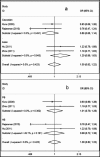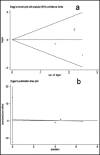XRCC1 Arg280His polymorphism and glioma risk: A meta-analysis involving 1439 cases and 2564 controls
- PMID: 24353504
- PMCID: PMC3809186
- DOI: 10.12669/pjms.291.2694
XRCC1 Arg280His polymorphism and glioma risk: A meta-analysis involving 1439 cases and 2564 controls
Abstract
Objectives: Previous reports indicated that XRCC1 Arg280His polymorphism might be a possible risk factor for several cancers. Published studies on the association of XRCC1 Arg280His polymorphisms with glioma risk have yielded controversial results. The present study aimed to derive a more precise estimation of the relationship.
Methodology: Meta-analyses assessing the association of XRCC1 Arg280His variation with glioma were conducted and subgroup analyses on ethnicity and source of controls were further performed. Eligible studies for the period up to May 2012 were identified.
Results: A total of four case-control studies comprising 1439 cases and 2564 controls were selected for analysis. The overall data indicated no significant association of XRCC1 Arg280His polymorphism with glioma risk (His vs Arg: OR=1.05; 95%CI=0.88-1.25; His/His vs Arg/Arg: OR=1.42; 95%CI=0.87-2.29; dominant model: OR=1.00; 95%CI=0.82-1.22; recessive model: OR=1.41; 95%CI=0.88-2.25). Likewise, in the subgroup analysis regarding ethnicity and source of controls, no associations were observed.
Conclusion: The results of the present study failed to suggest an association of XRCC1 Arg280His polymorphism with glioma risk. Further large and well-designed studies are needed to confirm this conclusion.
Keywords: Glioma; Malignancy; Meta-analysis; Polymorphism; Susceptibility; XRCC1 Arg280His.
Figures



References
-
- Montelli TdeC, Peracoli MT, Rogatto SR, Kaneno R, do PradoCH, Rocha PdeM. Genetic and modifying factors that determine the risk of brain tumors. Cent Nerv Syst Agents Med Chem. 2011;11(1):8–30. - PubMed
-
- Blaisdell JO, Harrison L, Wallace SS. Base excision repair processing of radiation-induced clustered DNA lesions. Radiat Prot Dosimetry. 2001;97(1):25–31. - PubMed
-
- Ginsberg G, Angle K, Guyton K, Sonawane B. Polymorphism in the DNA repair enzyme XRCC1: utility of current database and implications for human health risk assessment. Mutat Res. 2011;727(1-2):1–15. - PubMed
LinkOut - more resources
Full Text Sources
Molecular Biology Databases
